| Article ID | Journal | Published Year | Pages | File Type |
|---|---|---|---|---|
| 9610286 | Catalysis Today | 2005 | 5 Pages |
Abstract
The effect of cobalt precursor, catalyst pretreatment and promotion with ruthenium and rhenium on the formation of cobalt metal nanoparticles and catalytic performance of supported Fischer-Tropsch (FT) catalysts was studied using a combination of techniques (DSC-TGA, UV-vis spectroscopy, XPS, XRD, EXAFS-XANES, in situ magnetization measurements, propene chemisorption and catalytic measurements). The cobalt promoted and unpromoted catalysts were prepared by aqueous co-impregnation using cobalt nitrate or acetate, ruthenium nitrosyl nitrate or perrhenic acid. In both unpromoted and Ru and Re-promoted cobalt catalysts after impregnation and drying, cobalt is present mainly in octahedrally coordinated complexes. The repartition of cobalt species between Co3O4 and cobalt silicate depends essentially on the exothermicity of precursor decomposition. Cobalt nitrate precursor, with an endothermic decomposition, favors Co3O4 crystallites. Lower temperature of cobalt nitrate decomposition and catalyst calcination generally leads to higher dispersion of supported cobalt oxide. Cobalt acetate precursor, with an exothermic decomposition, favors cobalt silicate. By optimizing the conditions of cobalt acetate decomposition, the fraction of cobalt silicate can be decreased favoring a more reducible Co3O4 phase. For the catalysts prepared from cobalt nitrate, promotion with ruthenium increases the cobalt dispersion, while maintaining high reducibility. For the catalyst prepared via low temperature decomposition of cobalt acetate, addition of ruthenium increases the fraction of Co3O4 crystalline phase and decreases the concentration of barely reducible cobalt silicate. The Fischer-Tropsch reaction rates over unpromoted and promoted cobalt catalysts were found to be primarily a function of the number of cobalt metal sites, which are generated by the reduction of Co3O4 crystallites.
Keywords
Related Topics
Physical Sciences and Engineering
Chemical Engineering
Catalysis
Authors
J.-S. Girardon, A. Constant-Griboval, L. Gengembre, P.A. Chernavskii, A.Y. Khodakov,
